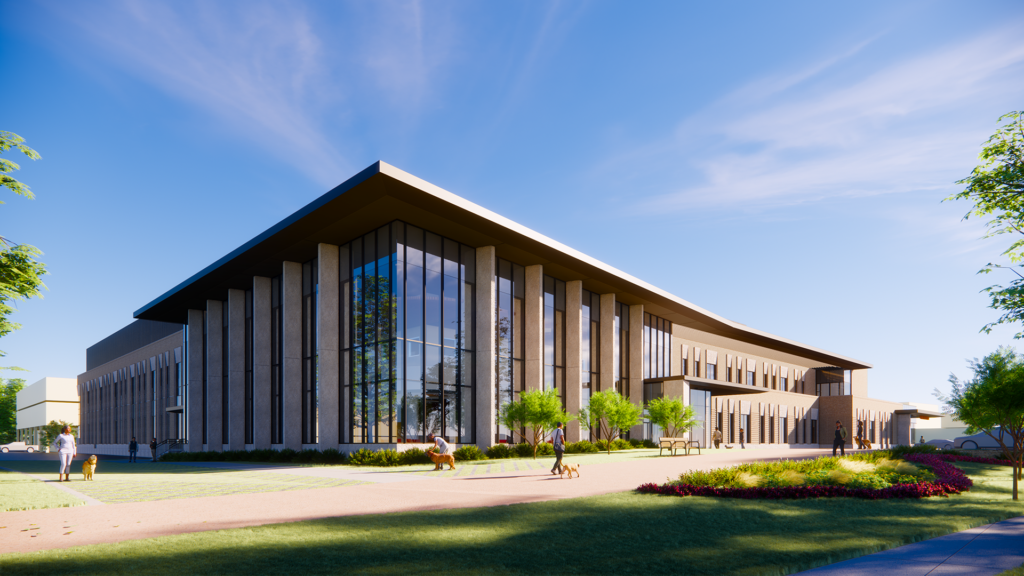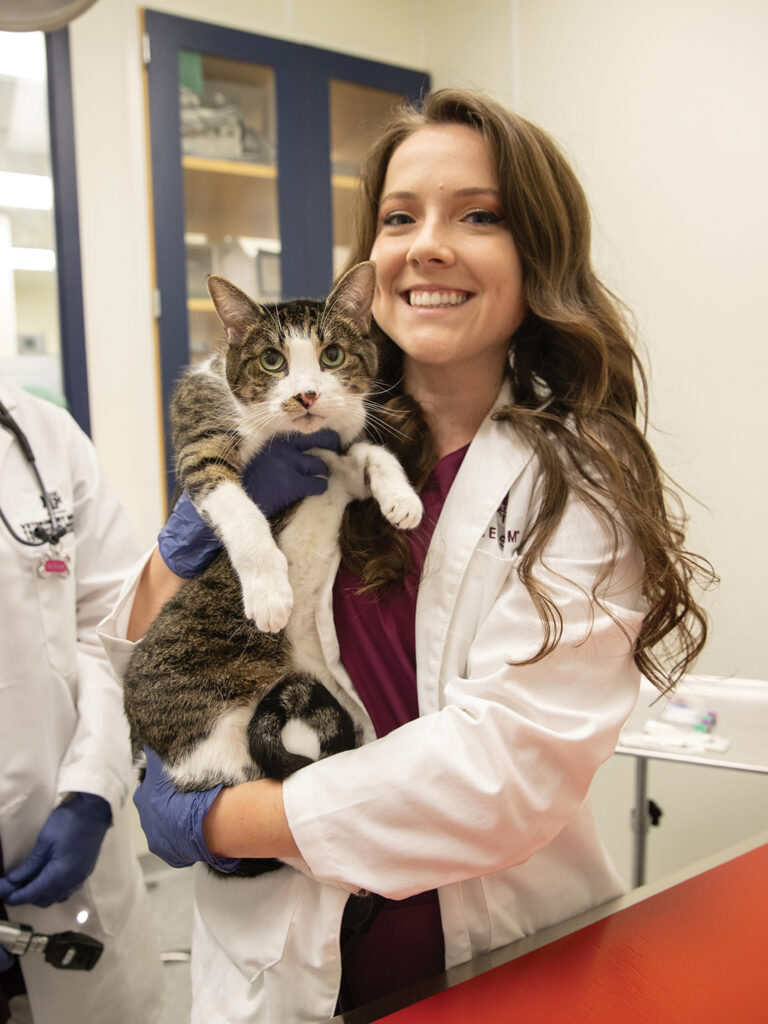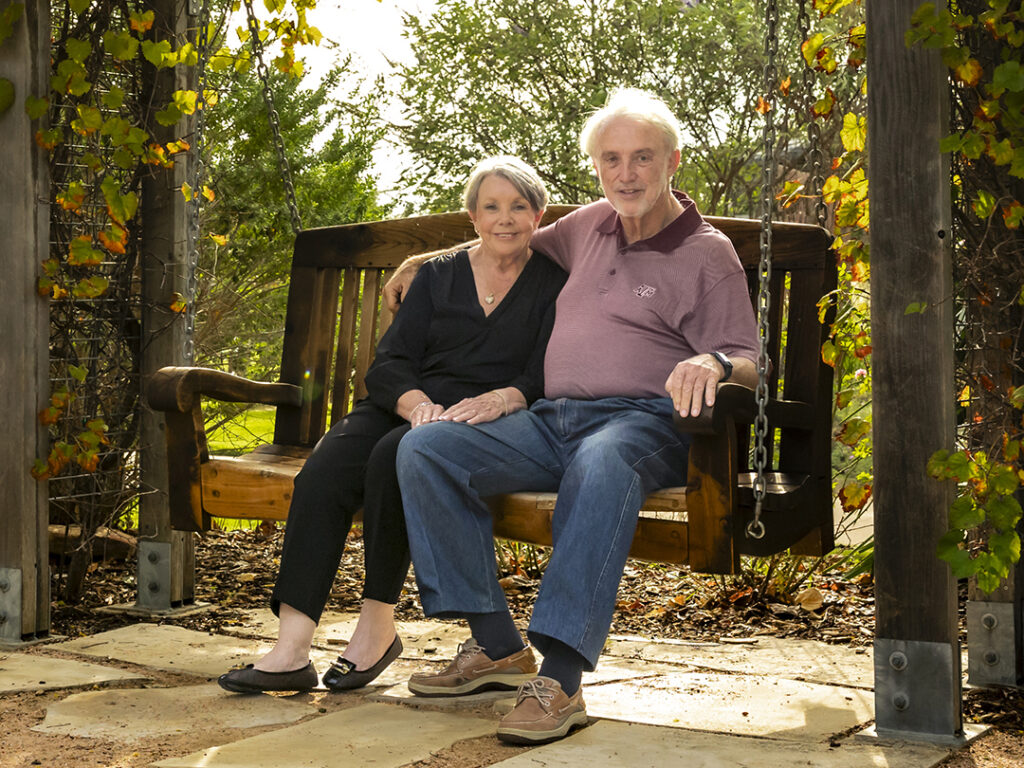Texas A&M University System Regents Pave Way For New Veterinary Teaching, Research Hospital
Story by Jennifer Gauntt, College of Veterinary Medicine & Biomedical Sciences

The Texas A&M University System Board of Regents has approved construction of the Texas A&M College of Veterinary Medicine & Biomedical Sciences’ (VMBS) new Clinical Veterinary Teaching & Research Complex (CVTRC), paving the way for groundbreaking and construction to begin on the $181 million small animal hospital.
The approximately 135,000 square-foot building will be located on the corner of Agronomy Road and Raymond Stotzer Parkway, where Veterinary Medical Sciences Building 507 currently stands and approximately 500 feet from the location of the current Small Animal Teaching Hospital (SATH).
“Texas A&M University has the finest veterinary college in the country,” said John Sharp, chancellor of The Texas A&M University System. “This new facility is going to allow us to do more of the important and pioneering work that we are known to do.”
The fundraising campaign for the building was officially announced in March 2023, with the lead, $20-million gift from Linda & Dennis Clark ’68 ’71. The project also has received generous support from the Texas Legislature, the Texas A&M University System, and Texas A&M University, as well as many other alumni and friends, whose partnerships generated more than $10 million during the campaign’s quiet phase.
“Our College of Veterinary Medicine & Biomedical Sciences takes on some of the most challenging cases imaginable,” said General (Ret.) Mark A. Welsh III, president of Texas A&M. “People bring their pets and working animals here because of the reputation of our world-class veterinarians, researchers, and student veterinarians in training. They know that not only will their pets receive the best care, but they will be treated with compassion and kindness. I know; my dogs have been on the receiving end of that tremendous care. This gift from the Clarks will enable us to have an even greater impact on the field of veterinary medicine and ensure we are able to continue this important work.”
“This is a very exciting time for the College of Veterinary Medicine & Biomedical Sciences,” said Dr. John R. August, the Carl B. King Dean of Veterinary Medicine. “A once-in-a-generation project, this new hospital will ensure that Texas A&M continues to lead the nation in veterinary education. The new facility will offer much-needed space for our world-class veterinary clinicians, residents, interns, support staff, and students in which to work, learn, and provide compassionate care to our patients as well as to conduct the groundbreaking clinical trials that advance the veterinary profession as a whole.”
Inside The New Hospital

The facility will house 15 of the SATH’s specialty referral services, including oncology, neurology, ophthalmology, dentistry, nutrition, and interventional radiology. There also will be more space allocated for the SATH’s Emergency Service and Intensive Care Unit, the busiest areas of the hospital, as well as double the number of surgical suites and exam rooms.
Additional faculty, staff, and student wellness spaces; client comfort rooms; a pharmacy; space for diagnostic imaging; and areas for training and other building support will also be located within the new building.
“At Texas A&M, we see a wide variety of cases – from primary to tertiary care – that have seen multiple specialists before us. We often see the sickest, most complicated cases, and for many of our patients and their owners, we are their last hope,” said Dr. Stacy Eckman, VMBS associate dean for hospital operations and Veterinary Medical Teaching Hospital (VMTH) chief executive officer. “Our students, faculty, and staff are extremely passionate about what they do, and they – as well as our clients and patients – deserve a hospital that is representative of the exceptional work that occurs within our walls.
“We are excited about having a new hospital that is designed for the cutting-edge medicine and surgery we practice but also is designed in a way that will give us flexibility over the next decades as the profession continues to expand and change,” Eckman said.
Meeting Modern Needs
As part of Texas A&M’s Veterinary Medical Teaching Hospital – the only veterinary teaching hospital in Texas and Texas A&M’s largest hands-on learning laboratory – the new CVTRC will provide a training ground for the VMBS to build upon already-outstanding educational experiences for the next generation of Aggie veterinarians. It also will support the outstanding patient care, advanced clinical research, and the selfless service Aggies are known for.
Ranked No. 4 in the nation and No. 7 in the world, Texas A&M’s Doctor of Veterinary Medicine (DVM) program is one of the largest in the United States, currently enrolling 180 students each year; each of those students is trained for a full calendar year at the VMTH in the fourth and final year of their veterinary curriculum.
As a result of their exemplary training and experiential learning, Aggie fourth-year veterinary students consistently lead the nation in pass rates on the North American Veterinary Licensing Examination, which is required in order to practice veterinary medicine, with the past two DVM classes achieving a 99% pass rate.
In addition, the building will provide teaching and clinical spaces that reflect the substantive advancements — such as the emergence of new technologies, clinical trials, and veterinary specialties, including telemedicine — that have occurred in the field of veterinary medicine since the current SATH opened in 1981.
With this expansion of the veterinary profession over the last 40 years, the current SATH facility has become too small, creating challenges in accommodating the current veterinary class size, the increasing numbers of research projects and clinical trials, and the additional faculty and support staff necessary for the VMBS’ robust teaching, service, and research missions. While originally designed to support a caseload of 6,000, the SATH currently sees around 22,000 cases annually.

“When you look at what we have at Texas A&M University in terms of the potential of the veterinary school, it is enormous, but right now, it is being limited by the facilities that are currently available at the small animal hospital. If we really want the world-class small animal and research program that we imagine, then we need a world-class facility,” said Dennis Clark.
“For me, the words ‘Aggie’ and ‘ideal’ are just about synonymous. Aggie veterinarians are an example of both. Aggie vets come out of school with a degree of empathy that is different from a lot of other universities,” Clark said. “The standard of care they offer is better because they are more involved, more concerned, and more committed to getting the best possible outcome for their patients. I think all vets want the outcome to be good, but Aggie veterinarians are willing to go the extra mile to make sure that the most appropriate outcome occurs.”
In support of the need for additional space, SATH services such as Primary Care Services and Rehabilitation as well as hospital administration will remain in their current locations and will continue to work with the specialty services in the CVTRC to provide clients and patients with an exceptional experience.
“Because the majority of our DVM graduates serve the profession as general practitioners, it is of the utmost importance that the VMBS be able to provide exceptional primary care space for client, patient, and student interactions,” August said. “Adequate space for our teaching mission promotes the development of the foundational competencies our veterinary medical students need so that they can enter the profession as career-ready veterinarians with immediate confidence.”
Looking Ahead
Vaughn Construction will begin the first phase of the CVTRC project, placing fencing around the project site, followed by abatement and demolition of Veterinary Medical Sciences Building 507 through April. Phase two will follow, with site preparation and construction of the building foundation beginning in June.
The new hospital – designed by Page Southerland Page architects, with associate architect Foil Wyatt – is slated for occupancy in August 2027.
For more information on the CVTRC, visit nextgenvethospital.tamu.edu; to learn more about supporting the project through financial gifts, contact the VMBS Office of Development at 979-845-9043.
As the Texas A&M College of Veterinary Medicine & Biomedical Sciences advances this transformative project, we are actively working to raise an additional $20 million through fundraising and partnerships over the next several years. We invite you to join us in shaping the future of veterinary medicine by contributing to this vital initiative. For more information on supporting this endeavor, please visit nextgenvethospital.tamu.edu or contact the VMBS Office of Development at 979-845-9043.
###
For more information about the Texas A&M College of Veterinary Medicine & Biomedical Sciences, please visit our website at vetmed.tamu.edu or join us on Facebook, Instagram, and Twitter.
Contact Information: Jennifer Gauntt, Director of VMBS Communications, Texas A&M College of Veterinary Medicine & Biomedical Sciences, jgauntt@cvm.tamu.edu, 979-862-4216


